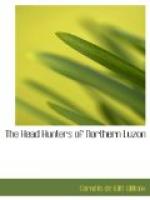“Nagukaran is one rancheria of several in a very large valley. When I reached a point in the trail commanding this valley, there could be seen from various rancherias in the valley a procession from each of them wending their way slowly toward Aliguyen’s home. From the time that they came within sight of the house, which was sometimes when they were a mile and a half or two miles from it, each procession danced its way, beating on the striped shields with their drum-sticks and on their bangibang. This last is a kind of wooden stick, made of resonant hard wood, coated over with chicken blood. It is extremely old. It is curved slightly and is about two feet long, and is held in one hand suspended by a bejuco string so that the vibrations are not interfered with. It is beaten with a drum-stick, as is also the shield. The gansa, or brass gong, the usual musical instrument of the Ifugaos, is never used in the funeral of a beheaded man. The two men who headed each procession carried two spears each. Behind came a man carrying a spear and shield. The two in front faced the on-coming procession, stepping most of the time backward, making thrusts toward the two who bore the spears and shields. The bearers of spear and shield made thrusts at them, the whole being a dance which in some respects resembles one of the head-dances of the Bontoc Igorots. From the high place on the trail where I was, they looked, in the distance, like nothing so much as columns of centipedes or files of ants all creeping slowly along the dikes of the rice-paddies toward the central place. It usually takes an hour for such a procession to cover one mile. The beating of shield and stick could easily be heard across the wide valley on that still morning.
“Arriving at Aliguyen’s house, we found him sitting on a block facing the sun, lying against his shield, which was supported by the side of the house. The body was in a terrible state of decomposition. It was swollen to three times its living girth. Great blisters had collected under the epidermis, which broke from time to time, a brownish red fluid escaping. The spear wound in his neck was plugged by a wooden spear-head. In each hand Aliguyen held a wooden spear. No attempt whatever had been made to prevent decomposition of the body or the entrance to it of flies. From the mouth gas bubbled out continually. Two old women on each side with penholder-shaped loom-sticks about two feet long continually poked at Aliguyen’s face and the wound to wake him up. From time to time they caught the grewsome head by the hair and shook it violently, shouting, Who-oo-oo! Aliguyen, wake up! Open your eyes! Look down on Kurug. [Kurug being the rancheria from which came Aliguyen’s murderer.] Take his father and his mother, his wife and his children, and his first cousins and his second cousins, and his relatives by marriage. They wanted him to kill you. All your kin are women. [They say this in order to deceive Aliguyen into avenging himself.] They can’t avenge you. You will have to avenge yourself! There is orden [law]; no one can kill them but you! Take them all!




